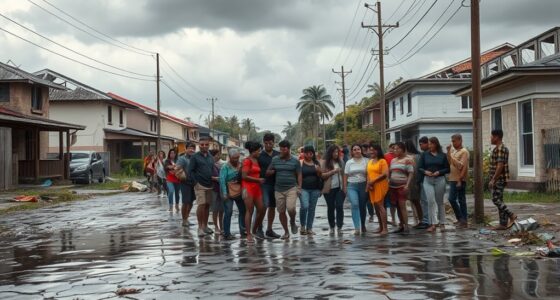Hurricane Katrina taught us valuable lessons about recovery and resilience. It highlighted the need for better preparedness, infrastructure improvements, and effective disaster response. The extensive damage to homes and economies showed that rebuilding efforts must prioritize community needs. Additionally, tackling environmental contamination and addressing humanitarian issues are essential for long-term recovery. By understanding these lessons, you can better equip yourself for future disasters. Discovering more about the ongoing impacts and strategies will deepen your insight.
Key Takeaways
- Effective disaster preparedness measures significantly reduce long-term economic impacts and improve community resilience against future hurricanes.
- Collaboration between federal, state, and local agencies is crucial for efficient recovery and rebuilding efforts post-disaster.
- Investing in infrastructure improvements, especially levees and utilities, is essential for protecting vulnerable communities.
- Environmental monitoring and pollution control are vital for safeguarding public health after major natural disasters.
- Comprehensive housing initiatives help restore social stability and support displaced populations during recovery phases.

Two decades have passed since Hurricane Katrina released its fury on the Gulf Coast, leaving a lasting mark on the region and the nation. The storm, which reached Category 5 intensity before making landfall as a strong Category 3, devastated Louisiana and Mississippi. It stands as one of the deadliest hurricanes in U.S. history, with over 1,300 fatalities, primarily in New Orleans. The hurricane’s storm surge recorded on the Mississippi coast remains the highest ever documented in the country, signifying the sheer force of nature that wreaked havoc on communities.
The economic aftermath of Katrina was staggering. You might recall how the storm destroyed over 300,000 single-family homes, making it the costliest hurricane on record at that time. Damage ran into billions of dollars, crippling local economies and leaving long-term financial burdens for many communities.
Infrastructure suffered significant damage as levees, roads, and utilities were compromised, underscoring the need for better preparedness in the face of natural disasters.
Environmental impacts were just as severe. With hazardous chemical facilities affected, pollution spread widely, contaminating drinking water and compromising wastewater systems. Flooding of Superfund sites released toxic materials, threatening local wildlife and ecosystems.
Recovery efforts have since focused on restoring ecological balance, highlighting the ongoing challenges posed by such disasters.
The humanitarian crisis resulting from the storm was monumental. Hundreds of thousands were displaced, requiring a massive humanitarian response to assist those in need. The standing water and pollution presented health risks, compounding the social and community disruptions faced by affected populations.
Recovery, as you may know, has been fraught with challenges, particularly concerning housing and infrastructure rebuilding.
In the wake of Katrina, extensive recovery and rebuilding efforts have taken shape. You might find it encouraging that there’s been significant work done to reconstruct levees, roads, and essential infrastructure while also focusing on housing initiatives for displaced residents.
Community revitalization programs have emerged, aimed at restoring the social fabric and enhancing resilience against future disasters.
Moreover, the lessons learned led to significant policy changes. The federal response to disasters has improved, incorporating better preparedness measures. These changes demonstrate a commitment to safeguarding communities and minimizing the impact of future hurricanes.
As we reflect on Katrina’s legacy, it’s clear that the journey of recovery continues, teaching invaluable lessons for future resilience.
Frequently Asked Questions
What Were the Main Causes of Hurricane Katrina’s Devastation?
The main causes of Hurricane Katrina’s devastation stem from a combination of storm characteristics and infrastructure failures.
You faced intense winds, heavy rainfall, and a massive storm surge, which overwhelmed the levee system.
Design flaws and overtopping led to catastrophic flooding, while inoperable pump stations failed to remove water.
The result was extensive damage and loss of life, illustrating the critical need for improved emergency preparedness and resilient infrastructure in vulnerable regions.
How Did Local Communities Respond During the Hurricane’s Aftermath?
Local communities mobilized quickly during the aftermath, focusing on their immediate needs.
You’d see neighbors come together, sharing resources and information. Music often served as a unifying force, lifting spirits and promoting engagement.
Many residents took charge of recovery efforts, ensuring they addressed their unique challenges. However, older populations were sometimes overlooked, with most initiatives geared towards younger residents.
This grassroots approach reflected resilience and creativity in the face of overwhelming adversity.
What Role Did the Federal Government Play in the Recovery Effort?
Isn’t it ironic how the federal government, tasked with disaster recovery, often struggles to coordinate effectively?
In the aftermath of a disaster, you’ll notice federal agencies mobilizing resources and personnel, but the initial response can be slow. They provide critical support, yet gaps in communication with local authorities often surface.
While federal involvement is essential, it’s clear that improving collaboration and preparedness is vital for a more effective recovery effort in the future.
How Has Hurricane Katrina Influenced Current Disaster Preparedness Policies?
Hurricane Katrina’s impact reshaped disaster preparedness policies considerably.
You’ll notice that legislation now emphasizes better coordination among federal, state, and local authorities. Improved infrastructure investments aim to bolster resilience against future disasters.
Policies also focus on accessibility, ensuring everyone, including those with disabilities, can receive aid.
Additionally, the incorporation of environmental health assessments into planning helps address risks more effectively, making your community better prepared for potential natural disasters.
What Were the Long-Term Health Impacts on Affected Populations?
The long-term health impacts on affected populations often include a rise in chronic conditions, mental health issues, and physical ailments.
You might notice that many survivors struggle with anxiety, depression, and persistent health problems. Access to healthcare can be limited, complicating recovery efforts.
Environmental hazards and disrupted treatments exacerbate these challenges. It’s essential to recognize that the aftermath of such disasters affects not only immediate health but also long-term well-being for years to come.
Conclusion
As we reflect on the lessons from Hurricane Katrina, it’s clear that resilience is the heart of recovery. You’ve seen how communities rise like phoenixes from the ashes, rebuilding stronger and smarter. By embracing collaboration and innovation, you can turn challenges into stepping stones for a brighter future. Let’s carry these insights forward, ensuring that when the next storm comes, we’re not just surviving, but thriving, ready to face whatever waves life may throw our way.










